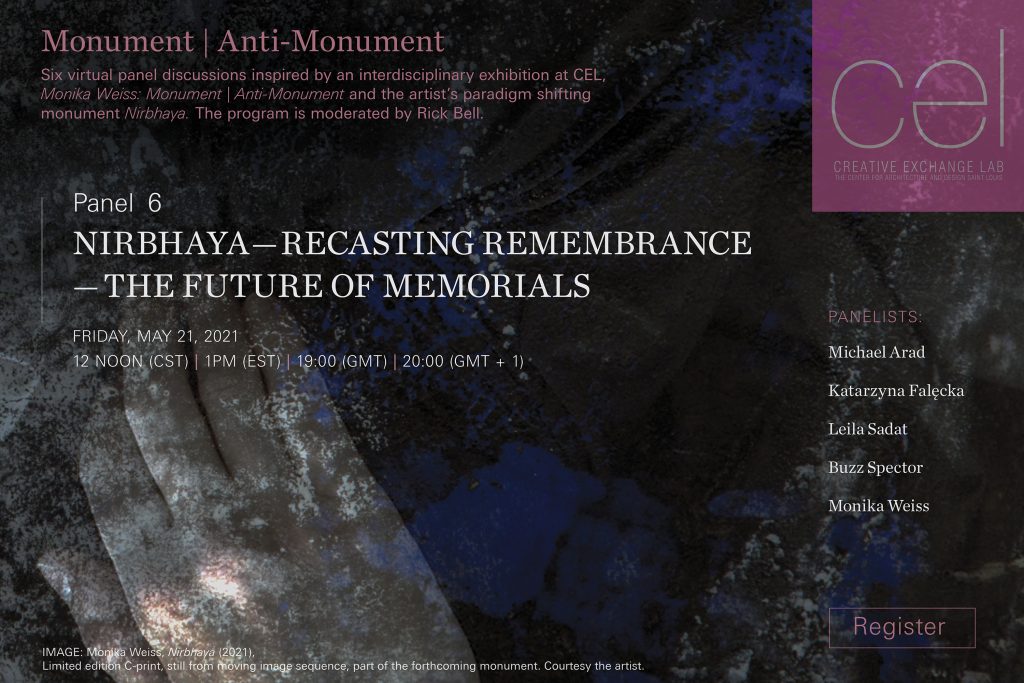Panel 6 – NIRBHAYA: THE FUTURE OF COLLECTIVE MEMORY

Panel 6 – Invited speakers: Michael Arad, Katarzyna Falecka, Leila Sadat, Buzz Spector, and Monika Weiss, moderated by Rick Bell.
Link to Recording of Panel 6: https://www.monikaweiss.net/monumentantimonument
Register and RSVP at: https://www.eventbrite.com/e/panel-6-nirbhaya-recasting-remembrance-the-future-of-memorials-tickets-151227049175
Monument | Anti-Monument
Creative Exchange Lab | Center for Architecture & Design STL (CEL), proudly announces a program of six virtual, international panel discussions collectively titled Monument | Anti-Monument. Moderated by Rick Bell, the program takes place in conjunction with two concurrent solo exhibitions: Monika Weiss – Monument | Anti-Monument (March 31st – April 22nd, 2021) at CEL, and Monika Weiss: Nirbhaya (March 27th – May 22nd, 2021) at the Centre for Polish Sculpture in Orońsko, a National Heritage Institution of Poland. Inspired by the work of the internationally celebrated Polish-American artist Monika Weiss and her paradigm-shifting monument/anti-monument project Nirbhaya the panels bring together artists, architects, activists, and historians to debate the role of monuments and commemorative design in shaping cultural identity in the public sphere.
The work of Monika Weiss is predicated on the act of unforgetting past traumas. It has particular resonance at this time when we rethink our histories and ways of remembering. In Nirbhaya, a memorial dedicated to victims of everyday violence that occurs globally, and named after Jyoti Singh, who was tortured, raped and killed at the age of 23 (posthumously named Nirbhaya, “Fearless” in Hindi) the artist transforms the traditional vertical form of a triumphal arch into a horizontal sarcophagus filled with water and moving image. This forthcoming permanent outdoor memorial by Monika Weiss will be built as two sister monuments, both in Poland and in the US. Polish location is in the public park of the Centre for Polish Sculpture in Orońsko. US location is co-organized in collaboration with Streaming Museum and will be announced soon. The six panel discussions are scheduled bi-weekly on Fridays: March 12, March 26, April 9, April 23, May 7 and May 21. All panels take place at 12 Noon (CST), 1PM (EST), 20:00 (GMT), 21:00 (GMT+1).
Panel 6 | Friday, May 21
NIRBHAYA: THE FUTURE OF COLLECTIVE MEMORY
The sixth and final panel of the series, Nirbhaya: The Future of Collective Memory explores potential functions and forms of monuments and memorials as catalysts of collective memory. The changing context of public visibility evokes Hannah Arendt’s term, the “space of appearance.” As an example, Nirbhaya is a work of art that calls for radical re-imagining of how, whom and what we choose to remember within and outside the traditional trajectories of heroic history. The discussion will include consideration of questions about the ways we imagine what Monika Weiss has called the “horizontal future of humanity.” It probes global and local value systems, hierarchies, and structures that lead to violence and enable selective erasure of the memory of events. Panelists will discuss their work in relation to collective memory and public space.
SPEAKERS BIOS
Jasmin Aber (host)
Jasmin Aber is the Director of the Creative Exchange Lab, and a licensed architect, trained in the United Kingdom. She is an urbanist with over twenty-five years of experience as a design practitioner. Jasmin is an academic, educator, mentor, and curator, as well as the co-founder and executive director of the CEL Center for Architecture and Design (CEL) in St. Louis. Her research work and design practice involve culture-led planning, utilizing music, art, and cultural heritage for placemaking and equitable and sustainable community and economic development. She is the co-curator of the 2019 exhibition Public Art, Public Memory: Who is Missing which engaged with contemporary discussion around expanding representation in our public monuments.
Rick Bell (moderator)
Rick Bell teaches at Columbia University where he is helps direct the Center for Buildings, Infrastructure and Public Space. A registered architect in New York, Rick previously served as Executive Director of Design and Construction Excellence at the NYC Department of Design and Construction. While Executive Director of AIA New York, he was instrumental in establishing and animating the Center for Architecture. He was also a member of the LMDC Committee that wrote the program for the National 9/11 Memorial at the World Trade Center. After architectural studies at Yale and Columbia, he worked in offices in New York, France, and Switzerland. He was on the advisory board of the inaugural NYC Architecture Biennial in 2020 and currently serves on the Board of the Creative Exchange Lab.
Monika Weiss
Over the past twenty-five years, the internationally celebrated Polish-American artist Monika Weiss has developed an aesthetic vocabulary of profound emotional impact that surpasses the limits of conventions around medium. Trained as a visual artist and classical pianist, Weiss creates synesthetic works, placing the visual on a par with the sonic and the haptic. A defining feature of Weiss’ practice is a commitment to exploring states of suspension or near stillness that disrupt the flow of time and hold a transformative potential. For Weiss, the poetic forms a language through which to explore the body, history, and violence. Her aesthetic vocabulary consists of recurring motives that include immersions in water, embryonic forms, the prostate body, lament, black cloth and digital doubling, forming a visual politics of affect. Weiss frequently employs her own body or choreographs other subjects, particularly women, to navigate histories of violence and sites of trauma. These works attend to the memorial landscapes of global conflicts like the Second World War, as well as to the recurring manifestations of gender-based violence. Public projects that take the form of ephemeral and site-specific environments constitute an important strand in Weiss’ practice. The artist’s exploration of public memory and cultural amnesia is underscored by a focus on the vulnerability of the female body in the context of the city. Weiss’ first permanent outdoor project Nirbhaya, a monument to victims of gendered violence, is planned concurrently in her native Poland (2021) and in the United States (2023).
Her solo museum exhibitions include the 2005 retrospective at the Lehman College Art Gallery (CUNY) Five Rivers, reviewed in The New York Times, as well as Sustenazo, commissioned by the CCA ZamekUjazdowski in Warsaw, Poland (2010), later travelling to the Museum of Memory & Human Rights, Santiago, Chile (2012-2013) and the Patricia & Phillip Frost Art Museum, Miami (2014). In 2004 Remy Toledo Gallery, New York, in cooperation with Galerie Samuel Lallouz, Montréal, organized a two-person exhibition of Carolee Schneemann and Monika Weiss. Weiss has exhibited alongside artists including Louise Bourgeois, Ana Mendieta, Mona Hatoumand Shirin Neshat. Group exhibitions include an international video art survey at the Stavros Niarchos Foundation, Athens, Greece (2016); Forms of Classification: Alternative Knowledge and Contemporary Art and The Prisoner’s Dilemma at the Cisneros Fontanals Art Foundation/CIFO, Miami (2006 and 2008); Drawing Now: Between The Lines of Contemporary Art at Loughborough University, UK (2009), Alan Sondheim & Monika Weiss – Enunciation at Eyebeam, New York (2012) and the inaugural exhibition at Prague’s Muzeum Montanelli (MuMo) (2010). Her works are included in public and private collections worldwide, including Albertina Museum, Vienna, AU; Cisneros FontanalsArt Foundation/CIFO, Miami, FL; Hudson Valley Center for Contemporary Art, Peekskill, NY; Frauenmuseum, Bonn, DE; CCA Zamek Ujazdowski, Warsaw, PL; and Dimas de Melo Pimenta’s collection, Locarno, SW. The artist was born in Warsaw, Poland and has lived in New York City since 2000. The artist currently divides her time between New York and St. Louis, where she is on the faculty of the Sam Fox School of Design & Visual Arts, Washington University.
The Nirbhaya monument by Monika Weiss is featured in the upcoming issue of Centerpoint Now, the publication of the World Council of Peoples for the United Nations (WCPUN), produced in collaboration with Streaming Museum, that highlights issues on the agenda of the international community and marks 75th Anniversary of the United Nations.
As part of The Metropolitan Museum of Art series Artists on Art, a 30-minute film with Monika Weiss will premiere on March 30th, in which the artist will talk about her response to Goya’s graphic works and discuss her own practice.
Michael Arad
Michael Arad’s design for the National September 11 Memorial at the World Trade Center site, titled “Reflecting Absence,” was selected by the Lower Manhattan Development Corporation from among more than 5,000 entries submitted in an international competition held in 2003. Mr. Arad joined Handel Architects as a Partner in April 2004 where he worked on realizing the Memorial design as a member of the firm.
A native of Israel, Mr. Arad was raised there, the U.K., the United States and Mexico. He came to the United States and earned a B.A. from Dartmouth College in 1994 and a Master of Architecture from the Georgia Institute of Technology in 1999.
Dr Katarzyna Falęcka
Dr Katarzyna Falęcka is a Lecturer in Art History at Newcastle University, specializing in modern and contemporary art from North Africa and the Middle East. She holds a PhD from University College London and co-leads a program in modern art history at the Centre d’Études Maghrébines à Tunis. She is curator of the exhibition Beyond Metaphor: Women and War at apexart, New York (27 May-31 July 2021) and author of scholarly articles, including in In Search of Archives, eds. Sarah Dornholf and Nadia Sabri (Berlin: Archive Books, 2021) and African Arts.
Leila Nadya Sadat
Leila Nadya Sadat is the James Carr Professor of International Criminal Law at Washington University Law and former Director of the Harris World Law Institute at Washington University School of Law (2008-2020). Since 2012 she has served as Special Adviser on Crimes Against Humanity to the ICC Prosecutor, and in 2008 launched the Crimes Against Humanity Initiative to address the scourge of global atrocity crimes and draft a treaty on their punishment and prevention. In 2018, she launched the Gun Violence and Human Rights Initiative. Sadat is an award-winning scholar who recently received an Honorary Doctorate from Northwestern University. She is the President of the International Law Association (American Branch) and a member of the U.S. Council on Foreign Relations. Sadat will be a senior visiting scholar at Yale Law School in fall 2021.
Buzz Spector
Buzz Spectoris an artist and writer who recently moved to upstate New York. Drawing has been important to his studio practice from the beginning of his career, and Spector describes the systematic page tearing in many of his works with paper as edges becoming lines. In addition to artmaking, Spector is a widely published critical writer whose essays and reviews have appeared in Afterimage, American Craft, Artforum, and Art on Paper, among many other magazines and journals. He is emeritus professor of art in the Sam Fox School of Design & Visual Arts at Washington University in St. Louis.
